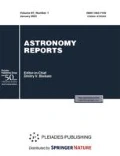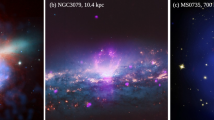Abstract
The origin of several rings in lenticular galaxies with no signs of ongoing or recent star formation (without emission lines and a signal in the ultraviolet spectral range) is investigated. Stellar population parameters—the average age and the magnesium–iron ratio—are measured; structural features are analyzed. It is concluded that the rings in all the galaxies have a different history of formation and a different nature; i.e., for only two of the four rings does the resonance origin associated with the dynamics of the central triaxial structure (bar) seem preferable.





Similar content being viewed by others
REFERENCES
G. de Vaucouleurs, Handbuch Phys. 53, 275 (1959).
S. Comerón, H. Salo, E. Laurikainen, J. H. Knapen, et al., Astron. Astrophys. 562, A121 (2014).
B. A. Vorontsov-Vel’yaminov, Sov. Astron. Lett. 2, 204 (1976).
M. P. Schwarz, Astrophys. J. 247, 77 (1981).
E. Athanassoula, A. Bosma, M. Crézé, and M. P. Schwarz, Astron. Astrophys. 107, 101 (1982).
R. Buta, Astrophys. J. Suppl. 61, 609 (1986).
J. C. Theys and E. A. Spiegel, Astrophys. J. 212, 616 (1977).
J. M. A. Few and B. F. Madore, Mon. Not. R. Astron. Soc. 222, 673 (1986).
V. A. Dostal’ and V. G. Metlov, Sov. Astron. 23, 1 (1979).
E. Athanassoula and A. Bosma, Ann. Rev. Astron. Astrophys. 23, 147 (1985).
M. Mapelli, B. Moore, E. Ripamonti, L. Mayer, M. Colpi, and L. Giordano, Mon. Not. R. Astron. Soc. 383, 1223 (2008).
K. Kuijken, D. Fisher, and M. R. Merrifield, Mon. Not. R. Astron. Soc. 283, 543 (1996).
T. A. Davis, K. Alatalo, M. Sarzi, M. Bureau, et al., Mon. Not. R. Astron. Soc. 417, 882 (2011).
I. Yu. Katkov, A. Yu. Kniazev, and O. K. Sil’chenko, Astron. J. 150, 24 (2015).
R. Buta and F. Combes, Fundam. Cosm. Phys. 17, 95 (1996).
I. Proshina, O. Sil’chenko, and A. Moiseev, Astron. Astrophys. 634, A102 (2020).
O. Sil’chenko and A. Moiseev, Astron. Astrophys. 638, L10 (2020).
J. S. Gallagher and A. Wirth, Astrophys. J. 241, 567 (1980).
P. Serra, T. Oosterloo, R. Morganti, K. Alatalo, et al., Mon. Not. R. Astron. Soc. 422, 1835 (2012).
T. Ashley, P. M. Marcum, M. Alpaslan, M. N. Fanelli, and J. D. Frost, Astron. J. 157, 158 (2019).
G. de Vaucouleurs, A. de Vaucouleurs, H. G. Corwin, Jr., R. J. Buta, G. Paturel, and P. Fouqué, Third Reference Catalogue of Bright Galaxies, Vol. 1: Explanations and References (Springer, New York, 1991).
M. P. Haynes, R. Giovanelli, A. M. Martin, K. M. Hess, et al., Astron. J. 142, 170 (2011).
G. Gavazzi, M. Fumagalli, M. Fossati, V. Galardo, F. Grossetti, A. Boselli, R. Giovanelli, and M. P. Haynes, Astron. Astrophys. 553, A89 (2013).
L. H. Wei, S. J. Kannappan, S. N. Vogel, and A. J. Baker, Astrophys. J. 708, 841 (2010).
V. L. Afanasiev and A. V. Moiseev, Astron. Lett. 31, 194 (2005).
V. L. Afanasiev and A. V. Moiseev, Baltic Astron. 20, 363 (2011).
G. Worthey, S. M. Faber, J. J. Gonzalez, and D. Burstein, Astrophys. J. Suppl. 94, 687 (1994).
C. P. Ahn, R. Alexroff, C. Allende Prieto, S. F. Anderson, et al., Astrophys. J. Suppl. 203, 21 (2012).
K. Sheth, M. Regan, J. L. Hinz, A. Gil de Paz, et al., Publ. Astron. Soc. Pacif. 122, 1397 (2010).
P. Erwin, J. E. Beckman, and M. Pohlen, Astrophys. J. 626, L81 (2005).
M. Pohlen and I. Trujillo, Astron. Astrophys. 454, 759 (2006).
D. Thomas, C. Maraston, and R. Bender, Mon. Not. R. Astron. Soc. 339, 897 (2003).
H.-S. Kim, J. Cho, R. M. Sharples, A. Vazdekis, M. A. Beasley, and S.-J. Yoon, Astrophys. J. Suppl. 227, 24 (2016).
F. Matteucci and L. Greggio, Astron. Astrophys. 154, 279 (1986).
G. Gilmore and R. F. G. Wyse, Astrophys. J. 367, L55 (1991).
R. Buta, Mon. Not. R. Astron. Soc. 470, 3819 (2017).
ACKNOWLEDGMENTS
The author thanks the staff of the Special Astrophysical Observatory, Russian Academy of Sciences, who maintained the spectral observations of galaxies with red rings: A.N. Burenkov, A.V. Moiseev, D.V. Oparin, V.L. Afanas’ev, and R.I. Uklein. As a source of photometric data, the author used the public archives of the SDSS-III project (http://www.sdss3.org), supported by the A.P. Sloan Foundation and the institutions of the SDSS collaboration, the National Science Foundation, and the US Department of Energy. In analyzing the data, the author used the NASA/IPAC Extragalactic Database (NED), operated by the Jet Propulsion Laboratory, California Institute of Technology, under contract with NASA. The images of the galaxies we presented using the capabilities of Legacy Survey (public domain) (http://legacysurvey.org).
Funding
Observations with the 6-m BTA telescope of the Special Astrophysical Observatory, Russian Academy of Sciences, were supported by the Ministry of Science and Higher Education of the Russian Federation (including contract no. 05.619.21.0016, UIP RFMEFI61919X0016). The ring study was supported by the Russian Foundation for Basic Research, project no. 18-02-00094.
Author information
Authors and Affiliations
Corresponding author
Additional information
Translated by A. Kobkova
Rights and permissions
About this article
Cite this article
Sil’chenko, O.K. Nature of Purely Stellar Rings in Lenticular Galaxies. Astron. Rep. 64, 985–993 (2020). https://doi.org/10.1134/S1063772920120136
Received:
Revised:
Accepted:
Published:
Issue Date:
DOI: https://doi.org/10.1134/S1063772920120136




